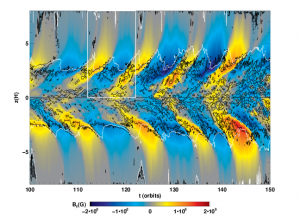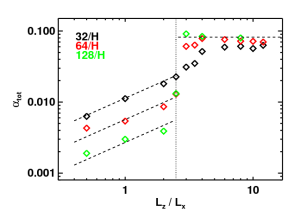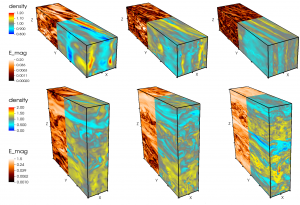MRI
MRI is a linear instability driven by exchange of angular momentum along magnetic field lines threading material at different distances from the central object. Its nonlinear evolution leads to MHD turbulence, which is believed to be the main mechanism that drives mass accretion onto objects such as young star, white dwarf, neutron star or black hole. As it strongly affects the origin and evolution of many astronomical objects, it is regarded as one of the fundamental instability in weakly magnetized plasma.

Since it is discovered in the early 90’s, significant progress has been achieved thankful for the increasing power of computers. In generally, the numerical simulations of MRI can be categorized according to the involving physical properties, geometry and approximations as shown in the left table. For example, the local, so-called shearing box, model can therefore be divided into four major types based on the initial magnetic field configuration and if vertical stratification is considered or not.
Numerical simulations have proved that the MRI drives sustained MHD turbulence in most of the models although it is unclear what mechanisms determines the saturation of amplitude of the turbulence. One particular model, the unstratified zero-net-flux  shearing box, shows decaying turbulence strength as the resolution increases probably owing to the lack of a physical lengthscale. Stratified shearing box simulations, in which the disk scaleheight servers as a physical length, clearly show converging or slightly increasing amplitude when resolution is improved (see our paper on ADS & astro-ph) . In addition, the averaged toroidal field flips signs periodically near the midplane before being expelled to higher altitude, a “butterfly” diagram which manifests some dynamo mechanisms as shown on the right.
shearing box, shows decaying turbulence strength as the resolution increases probably owing to the lack of a physical lengthscale. Stratified shearing box simulations, in which the disk scaleheight servers as a physical length, clearly show converging or slightly increasing amplitude when resolution is improved (see our paper on ADS & astro-ph) . In addition, the averaged toroidal field flips signs periodically near the midplane before being expelled to higher altitude, a “butterfly” diagram which manifests some dynamo mechanisms as shown on the right.
 Our more recent study (see paper on ADS & astro-ph) further shows that even in the unstratified boxes without initial mean magnetic flux, the saturation level of the stress is independent of numerical resolution when the vertical domain is extended Lz/Lx > 2.5 (see the left figure), and the converged level is greatly increased (giving a ratio of stress to pressure α ~ 0.1 in contrast to the usual 0.001-0.01 found in local simulations). We also observe a cyclic dynamo which generates patches of strong toroidal field that switches sign on scales of Lx in the vertical direction, resembling the ‘butterfly’ diagram found in
Our more recent study (see paper on ADS & astro-ph) further shows that even in the unstratified boxes without initial mean magnetic flux, the saturation level of the stress is independent of numerical resolution when the vertical domain is extended Lz/Lx > 2.5 (see the left figure), and the converged level is greatly increased (giving a ratio of stress to pressure α ~ 0.1 in contrast to the usual 0.001-0.01 found in local simulations). We also observe a cyclic dynamo which generates patches of strong toroidal field that switches sign on scales of Lx in the vertical direction, resembling the ‘butterfly’ diagram found in  stratified disks. We show that it is this dynamo action, which is inhibited when the vertical domain is small (see the comparison between short and tall boxes), that controls the MRI saturation in our taller boxes. The saturation amplitude is insensitive to whether or not explicit dissipation is included in the calculations, at least for large magnetic Reynolds and Prandtl number. We also show MRI turbulence in tall domains has a smaller critical Pmc (below which no sustained turbulence), and an extended lifetime compared to Lz/Lx < 1 boxes.
stratified disks. We show that it is this dynamo action, which is inhibited when the vertical domain is small (see the comparison between short and tall boxes), that controls the MRI saturation in our taller boxes. The saturation amplitude is insensitive to whether or not explicit dissipation is included in the calculations, at least for large magnetic Reynolds and Prandtl number. We also show MRI turbulence in tall domains has a smaller critical Pmc (below which no sustained turbulence), and an extended lifetime compared to Lz/Lx < 1 boxes.
 Turbulence and magnetic reconnection are two fundamental physical processes which often co-exist and interact in real systems. Previous works have primarily focused on either reconnection in forced homogeneous turbulence or turbulence originated from reconnection of current sheets. However, in astrophysical systems such as accretion disks, turbulence is believed to be driven by the magneto-rotational instability (MRI). In this study, we carry out very high resolution (10003 grid points) numerical simulations to investigate how does magnetic reconnection proceed in MRI-driven turbulent disks, and what are the statistical properties of the reconnection-related current sheets in accretion disks. The figure to left illustrate a blow-up 3D view of a strong current sheets associated with MRI channel modes, where Kelvin-Helmholtz-like instability produces interacting flux ropes which eventually lead to the destruction of the sheets.
Turbulence and magnetic reconnection are two fundamental physical processes which often co-exist and interact in real systems. Previous works have primarily focused on either reconnection in forced homogeneous turbulence or turbulence originated from reconnection of current sheets. However, in astrophysical systems such as accretion disks, turbulence is believed to be driven by the magneto-rotational instability (MRI). In this study, we carry out very high resolution (10003 grid points) numerical simulations to investigate how does magnetic reconnection proceed in MRI-driven turbulent disks, and what are the statistical properties of the reconnection-related current sheets in accretion disks. The figure to left illustrate a blow-up 3D view of a strong current sheets associated with MRI channel modes, where Kelvin-Helmholtz-like instability produces interacting flux ropes which eventually lead to the destruction of the sheets.